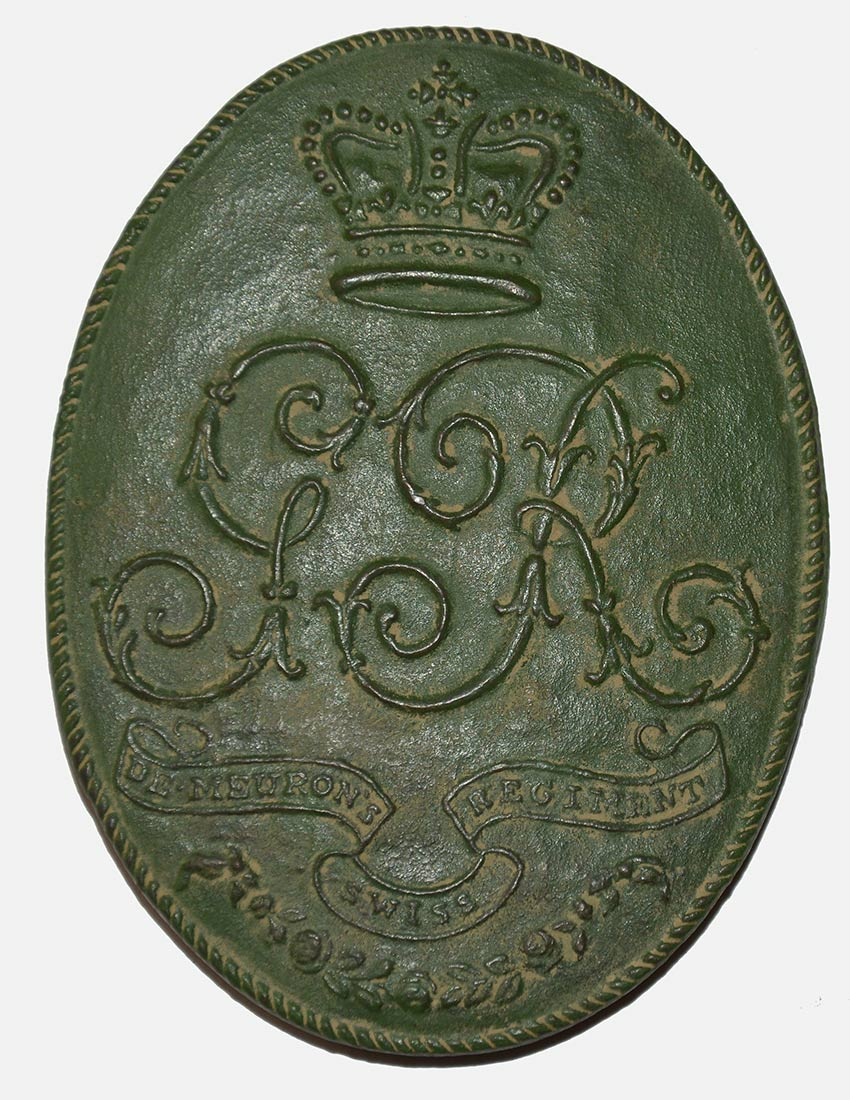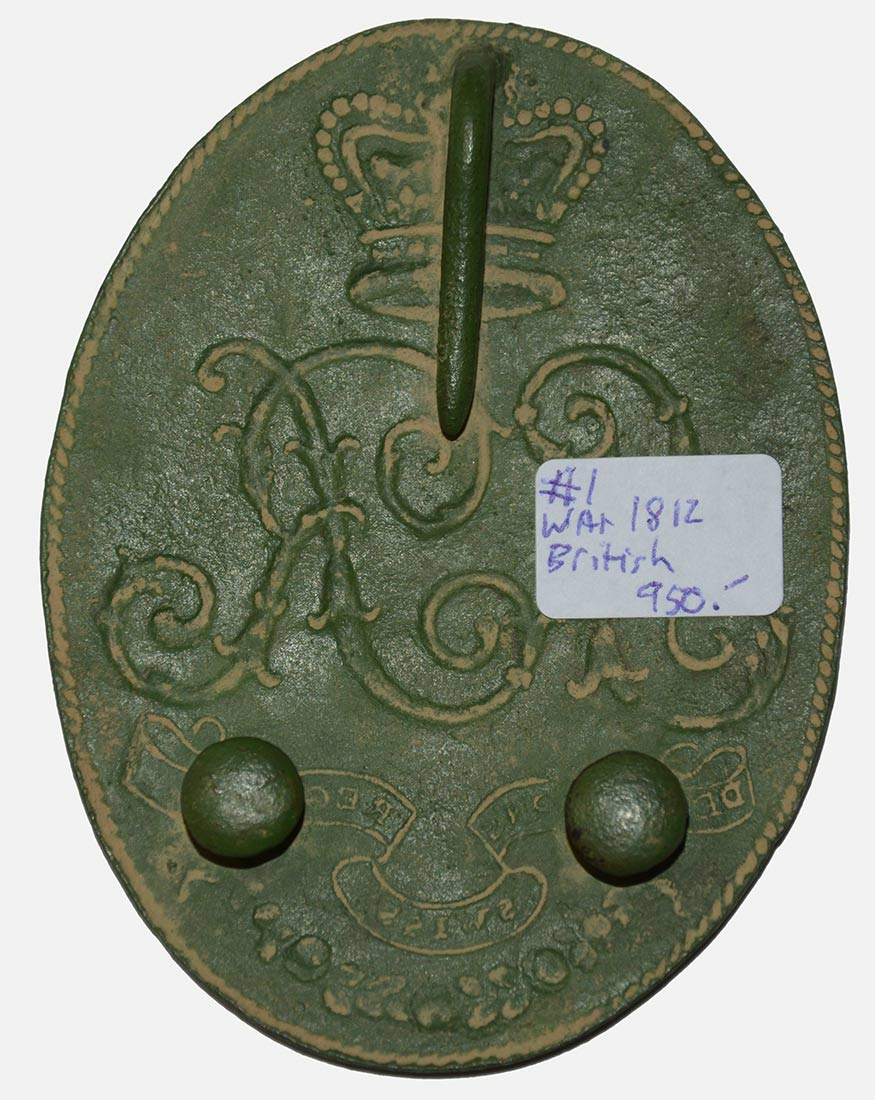site search
online catalog
VERY RARE EXCAVATED CROSSBELT PLATE OF DEMEURON’S SWISS REGIMENT: IN CONTINUOUS ACTION AT THE 1814 BATTLE OF PLATTSBURGH AND COVERING THE BRITISH RETREAT

Hover to zoom


$950.00 SOLD
Quantity Available: None
Item Code: 766-1934
This is a very rare British, War of 1812 regimentally-marked crossbelt plate from a well-regarded regiment, recovered near Chazy, NY, having been lost there either during skirmishes with American forces preliminary to the Battle of Plattsburgh in 1814, where the regiment fought and took losses, or in covering the British retreat, during which they formed the army’s rearguard. They had been taken into British service in 1795, shipped to America 1813, and in Prevost’s attack on Plattsburgh were among the first British Army units to arrive at the destroyed bridge across the Saranac River where they spent six days on the front line, engaged with American skirmishers and artillery, both land and naval, before covering the army’s retreat, a service commemorated in the inscription on the pike head of their regimental colors: “7 au 14 Septembre 1814 / a PLATZBOURG/ couvrant la retraite / de L’ARMEE ANGLAISE.”
The plate is perhaps the only one known from this regiment, at least from an American context, and was excavated on private property with the owner’s permission, showing several breaks and missing a piece near the crown. It has been professionally and carefully restored to near pristine excavated condition, with a pleasing olive-green patina, mixed with some grayish brown in recesses, and crisp detailing to the roped border, British crown, large script foliate “GR,” three-stage ribbon scroll reading “DEMEURON’S SWISS REGIMENT,” and a leafy branch/wreath at bottom. The fastening hook and belt studs are on place on the reverse. The repairs are imperceptible and the plate displays beautifully.
The unit had an interesting lineage, being raised for service as a Swiss mercenary regiment in the service of the Dutch East India Company by the Count De Meuron in 1781, serving first as marines, and then, about 1,000 strong, entering British service in Dutch Ceylon in 1795, after some diplomatic maneuvering following the French overthrow of the Dutch Republic. The regiment fought in India, was reduced by drafts to other regiments to about 200 and posted to England in 1806, and then served at Mediterranean posts in 1807 during the Peninsular War, being built up again, including by the addition of 500 Swiss and German prisoners take by the Spanish in 1808. They were well-regarded at the time for discipline, equipment, and conduct. R.L. Yaple rates them very highly in his study of foreign and emigrant regiments taken into the British army to solve manpower shortages during the period.
They sailed from Gibraltar for Canada in June 1813, again about 1,000 strong, along with a contingent of wives and children, arriving in August at Quebec, where they were tasked with defending the Richelieu River Valley, covering Lake Champlain and the St. Lawrence, a strategic position blocking potential American invasion of Lower Canada and, conversely, providing a route for a British invasion of New York and New England by an Army under Sir George Prevost, in concert with a British naval advance on Lake Champlain in August 1814.
The initial target was Plattsburgh and on Sept. 4 advancing British columns skirmished with American force who unsuccessfully sought to slow them down in the Chazy area. Two days later Demeuron’s regiment, part of Brisbane’s brigade, occupied Plattsburgh’s “lower town,” but was stalled by American destruction of the bridge across the Saranac river connecting it to the town’s “citadel,” containing several forts and artillery emplacements. The regiment spent six days exchanging fire with American skirmishers, losing at least 18 men by one account, and enduring artillery fire from land emplacements opposite and American naval vessels. In the main British attack of Sept. 11 they were to turn a feint into a real attack as British naval vessels neutralized American vessels and artillery, but the naval portion of the battle went awry, and the attack was called off. The regiment held the lower town as British artillery withdrew the next night, and formed the rearguard of the army with the regiment’s light company playing a prominent role both in the fighting and covering the withdrawal.
The regiment remained in Canada after the Treaty of Ghent ended the war in 1815, and was disbanded in 1816 with about half of the 700 men then on its rolls returning to Europe and half taking advantage of land grants and settling in Canada. The Company of Military Historians devoted a uniform plate to them in 1957 and there are numerous other articles available on their campaigns and service. This is a unique chance at a rare War of 1812 plate from a regiment with a combat record in America. [sr] [ph:L]
~~~~~~~~~~~~~~~~~~~~~~~~~~~~~~~~~~~
THIS ITEM, AS WITH ALL OTHER ITEMS AVAILABLE ON OUR WEB SITE,
MAY BE PURCHASED THROUGH OUR LAYAWAY PROGRAM.
CLICK HERE FOR OUR POLICIES AND TERMS.
THANK YOU!
Inquire About VERY RARE EXCAVATED CROSSBELT PLATE OF DEMEURON’S SWISS REGIMENT: IN CONTINUOUS ACTION AT THE 1814 BATTLE OF PLATTSBURGH AND COVERING THE BRITISH RETREAT
Most Popular
Historical Firearms Stolen From The National Civil War Museum In Harrisburg, Pa »
Theft From Gravesite Of Gen. John Reynolds »
Selection Of Unframed Prints By Don Troiani »
Fine Condition Brass Infantry Bugle Insignia »
Large English Bowie Knife With Sheath 1870’S – 1880’S »
Imported (Clauberg) Us Model 1860 Light Cavalry Officer's Saber »
featured item
IDENTIFIED CONFEDERATE 1/6 PLATE AMBROTYPE, J.H. DOYLE, 7TH S.C. CAVALRY
This ambrotype photograph features young James Hogan [Hagan] Doyle posing in plain uniform coat with hands across his waist. Three plain buttons are visible on his jacket which also has a standing collar. Image is clear with Doyle’s cheeks lightly… (141-190). Learn More »


